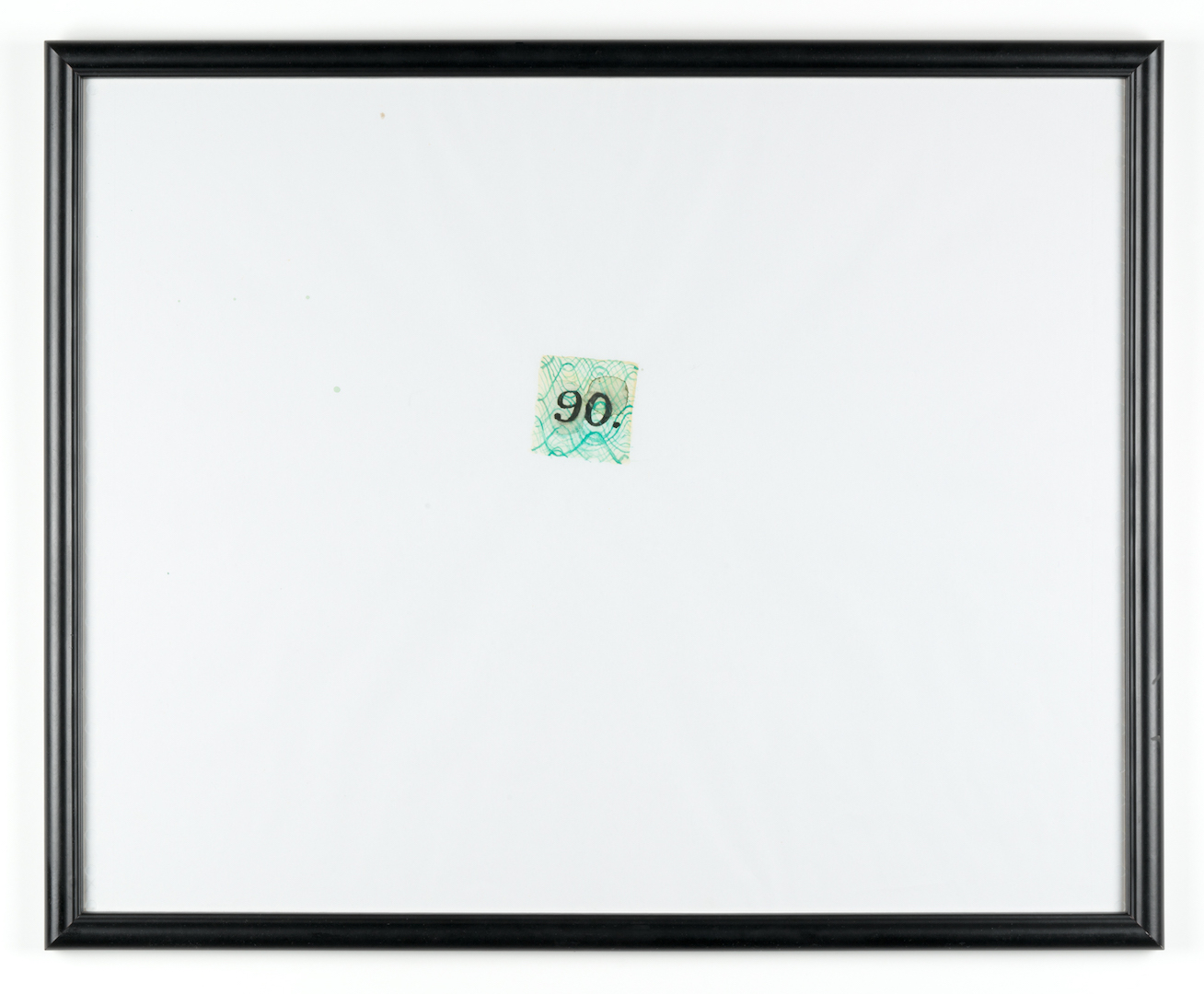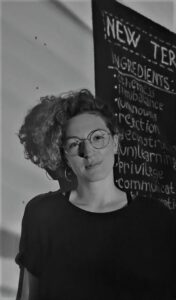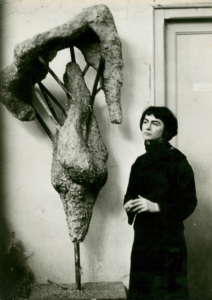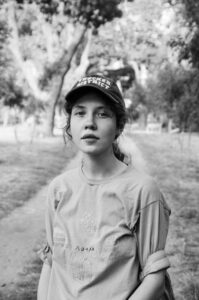Judit Fischer
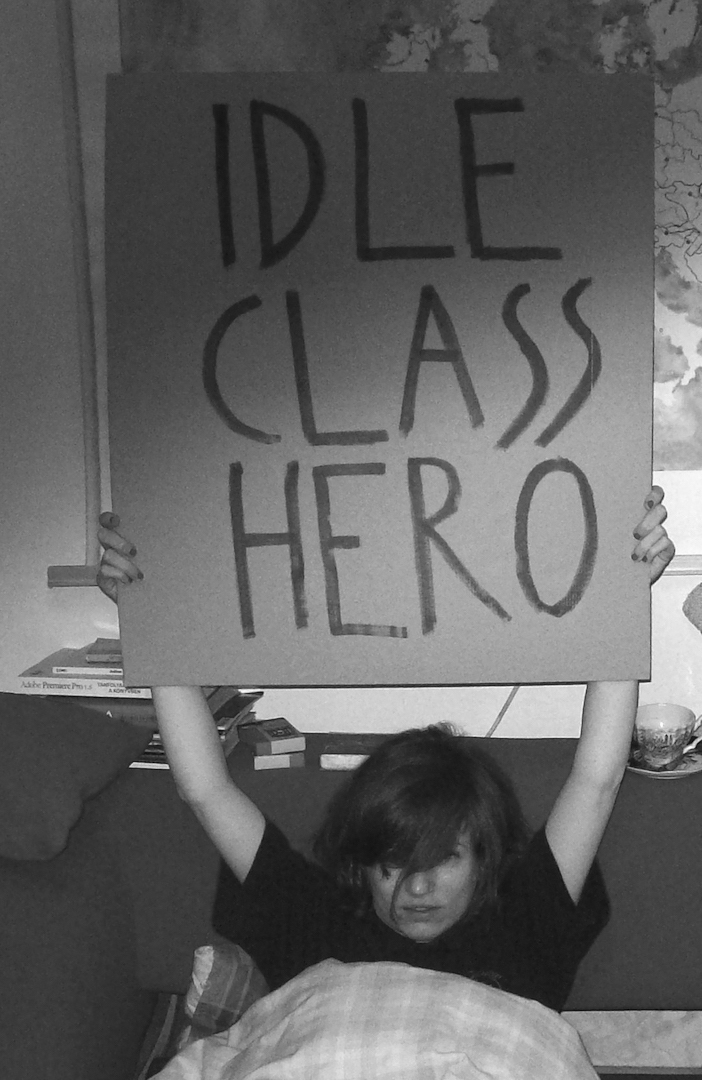
– born in 1981, Zalaegerszeg, graduated from the Painting Department at the Hungarian University of Fine Arts. In her mediatically diverse conceptual practice, she deals with the question of representation. In order to depict the everyday, ordinary, negligible objects, she primarily chooses the ordinary mediums of drawing, weaving or plasticine. Her size-identical “still lifes” that often depict hobby art supplies seem both thematically and technically to be school caricatures of high art. In her collaborative artistic practice, it is in the form of actions that she also draws attention to the everyday possible passages between life and art. She lives and works in Budapest
I think I’ve always tried not to attach too much importance to myself and my human being whatsoever.
Nevertheless, I have always found the world very exciting and interesting1.
I just like to sit and watch, observe, notice things.
One of my favourite texts is Mladen Stilinović’s The Praise of Laziness.
I want to be an artist like Eastern European artists that Stilinović describes: they do not impress with expensive materials or a lot of work, but with their ideas.
I came up with a strict set of rules for myself.
I paint ordinary objects in a 1: 1 size, isolated from their original environment.
I try to choose objects that have a simple, almost abstract appearance, that do not have many meanings associated to them, that are present in everyday life and are therefore relatively timeless – neither too modern nor too retro –, but are not paid too much attention to234.
This has gotten harder and harder over time, and I do think that I have already reviewed all objects of this kind.
There are types of objects that I especially like:
Junk art tools for example. Paints, brushes that are almost impossible to paint with.
I see them as a parody of painting5.
I also like the attributes of classic painters, the mic cap and the palette.
I will never be like this6.
My other favourites are crappy party supplies that are meant to make a special day even more special (sparklers, candles, inscriptions, cookies), but somehow it is our insignificance that they keep emphasizing78.
According to Heidegger, objects are present when they are broken or not in use.
When we use them, we don’t really think about them. As objects, purely in themselves, we only perceive those objects that are not in use.
It may be a romantic idea, but maybe my pictures work that way too. They let us see things we don’t see anyway, and that makes us a little more present too.
As a member and president of the World Association of Mouth and Brain Painters, co-founded with Miklós Mécs, I also take part in the creation of collaborative works. Usually we either take art out to the street or try to bring life (eating, drinking, sleeping, dancing) into the white cube910.
Although in my practice, the two directions building on gestures that disrupt or just turn everyday life or traditional enjoyment of art inside out may seem different, both require in fact similar distance-keeping and observational thinking.
I don’t feel strong enough to change the world, I rather run away from it and seek refuge in reality. As a result of the current Hungarian mafia politics that surpasses even my worst imaginations, does not use the Christian disguise anymore and obstructs all meaningful movements, the revolutionary heat that is usually very low in me is skyrocketing.
Even my 4-centimeter high demonstrating Christmas gingerbreads do blow the fuse111213.
This statement was edited in collaboration with curator Fanni Magyar (2021).
1Image: Judit Fischer, To start a war for Hungary to have the shape of a small dog, 2007, acrylic on canvas, 150 x 120 cm. Courtesy of the artist and Kisterem Gallery, Budapest.2Image: Judit Fischer, Portfolio CD, 2020, watercolour on paper, 21 x 29,7 cm. Courtesy of the artist and Kisterem Gallery, Budapest.
3Image: Judit Fischer, 300 Forints, 2020, watercolour on paper, 24,5 x 34,7 cm. Courtesy of the artist and Kisterem Gallery, Budapest.
4Image: Judit Fischer, Baby biscuits, 2020, watercolour on paper, 24,5 x 34,7 cm. Courtesy of the artist and Kisterem Gallery, Budapest.
5Image: Judit Fischer, Red-blue pencil, 2013, watercolour on paper, 21 x 29,7 cm. Courtesy of the artist and Kisterem Gallery, Budapest.
6Image: Judit Fischer, Palettes, 2017, paper collage, 70 x 100 cm. Courtesy of the artist and Kisterem Gallery, Budapest.
7Image: Judit Fischer, Burnt down sparkler, 2009, watercolour on paper, 24,5 x 34,7 cm. Courtesy of the artist and Kisterem Gallery, Budapest.
8Image: Judit Fischer, Red pompon, 2015, watercolour on paper, 31 x 38 cm. Courtesy of the artist and Kisterem Gallery, Budapest.
9Image: World Association of Mouth and Brain Painters (SZ.A.F.): Gon’t with the wind, 2018, public art project in the frame of “Stúdió ’18 – Salon | Erase the Future by all means”, exhibition of the Studio of Young Artists Association at the Hungarian University of Fine Arts – Barcsay Hall. Courtesy of the artist.
10Images: World Association of Mouth and Brain Painters (SZ.A.F.): Gon’t with the wind, 2018, public art project in the frame of “Stúdió ’18 – Salon | Erase the Future by all means”, exhibition of the Studio of Young Artists Association at the Hungarian University of Fine Arts – Barcsay Hall. Courtesy of the artist.
11Image:Judit Fischer, Usb cable, 2020, gobelin, 21 x 29,7 cm. Courtesy of the artist and Kisterem Gallery, Budapest.
12Image: Judit Fischer, Paper bag, 2013, watercolour on paper, 31 x 38 cm. Courtesy of the artist and Kisterem Gallery, Budapest.
13Image: Judit Fischer, Tombola ticket, 2013, watercolour on paper, 31 x 38 cm. Courtesy of the artist and Kisterem Gallery, Budapest.
– szül. 1981, Zalaegerszeg, a Magyar Képzőművészeti Egyetem festő szakán végezte tanulmányait. Mediálisan változatos konceptuális alkotói gyakorlatában a reprezentáció kérdésével foglalkozik. A jellemzően közönséges, elhanyagolható tárgyak megjelenítéséhez elsősorban a rajz, a szövés, vagy a gyurma hétköznapi médiumát választja. A gyakran hobby művészeti kellékeket ábrázoló méretazonos „csendéletei” mind témájukban, mind technikailag a magas művészet iskolás karikatúrájának hatnak. Kollaboratív alkotói gyakorlatában szintén az élet és a művészet közötti, mindennapi átjárási lehetőségekre irányítja a figyelmet akciók formájában. Budapesten él és dolgozik.
Azt hiszem mindig is törekedtem rá hogy magamnak, és egyáltalán az emberlétemnek ne tulajdonítsak túl nagy jelentőséget.
A világot viszont mindig is nagyon izgalmasnak és érdekesnek találtam1.
Szeretek csak ülni és nézni, megfigyelni, észrevenni dolgokat.
Egyik kedvenc szövegem Mladen Stilinović The Praise of Laziness című szövege.
Olyan művész szeretnék lenni, amilyennek Stilinović a kelet-európai művészeket leírja: nem drága anyagokkal vagy a sok munkával nyűgöznek le, hanem az ötleteikkel.
Kitaláltam magamnak egy szigorú szabályrendszert.
Hétköznapi tárgyakat festek 1:1 méretben, környezetükből kiemelve.
Olyan, megjelenésükben egyszerű, szinte absztrakt tárgyakat igyekszem választani, amik nem hordoznak sok eleve hozzájuk kapcsolt jelentést, jelen vannak a mindennapokban ezért viszonylag kortalanok − se nem túl maiak, se nem túl retrók −, de nem nagyon fordítunk rájuk figyelmet.234
Ez idővel egyre nehezebb, egyre inkább azt hiszem, hogy már minden ilyen tárgyat számba vettem.
Vannak tárgytípusok, amiket kifejezetten kedvelek:
Ilyenek az ócska művészeti eszközök. Festékek, ecsetek, amikkel szinte lehetetlen festeni.
A festészet paródiájának látom őket5.
Ugyanígy kedvelem a klasszikus festők attribútumait, a micisapkát és a palettát.
Ilyen sose leszek6.
Másik kedvenceim a gagyi partikellékek, amik egy különleges napot hivatottak még különlegesebbé tenni (csillagszórók, gyertyák, feliratok, aprósütemények), de valahogy mégiscsak a jelentéktelenségünket hangsúlyozzák78.
Heidegger szerint a tárgyak akkor vannak jelen, amikor töröttek, vagy nincsenek használatban.
Amikor használjuk, nem gondolunk rájuk. Tárgyként, tisztán önmagukban csak a használaton kívüli tárgyakat látjuk.
Lehet, hogy ez egy romantikus elképzelés, de talán az én képeim is így működnek. Látni engednek dolgokat, amiket amúgy nem látunk, és ettől mi is egy kicsit jobban jelen vagyunk.
A Mécs Miklóssal közösen alapított Szájjal és Aggyal Festők világszövetségének tagjaként és elnökeként kollaboratív művek létrehozásában is részt veszek. Általában vagy a művészetet cincáljuk az utcára, vagy az életet (evés, ivás, alvás, tánc) igyekszünk bevinni a white cube-ba910.
A hétköznapi életet vagy a hagyományos műélvezetet megzavaró vagy éppen kifordító gesztusokra építő két irány a művészetemben ugyan különbözőnek tűnhet, de valójában mindkettő hasonló távolságtartó, megfigyelő gondolkodást igényel.
A világ megváltoztatásához nem érzem elég erősnek magamat, inkább a valóságba menekülök előle. A jelenlegi, legrosszabb képzeleteimet is felülmúló, most már a keresztény álcát sem használó, minden értelmes megmozdulásnak keresztbetevő, maffiózó magyar politika hatására, a bennem amúgy sem túltengő forradalmi hév is soknak számít.
Még a 4 centis karácsonyi tüntető mézeskalácsaim is kiverik a biztosítékot111213.
A statement Fischer Judit és Magyar Fanni kurátor együttműködésében jött létre (2021).
1Kép: Fischer Judit, Azért háborúzni hogy kiskutya alakú legyen Magyarország, 2007, akril, vászon, 150 x 120 cm. A művész és a Kisterem galéria jóvoltából.2Kép: Fischer Judit, Portfólió CD, 2020, akvarell, papír, 21 x 29,7 cm. A művész és a Kisterem galéria jóvoltából.
3Kép: Fischer Judit, 300 Ft, 2020, akvarell, papír, 24, 5 x 34,7 cm. A művész és a Kisterem galéria jóvoltából.
4Kép: Fischer Judit, Babakekszek, 2020, akvarell, papír, 24, 5 x 34,7 cm. A művész és a Kisterem galéria jóvoltából.
5Kép: Fischer Judit, Piros-kék ceruza, 2013, akvarell, papír, 21 x 29,7 cm. A művész és a Kisterem galéria jóvoltából.
6Kép: Fischer Judit, Paletták, 2017, papírkollázs, 70 x 100 cm. A művész és a Kisterem galéria jóvoltából.
7Kép: Fischer Judit, Leégett csillagszóró, 2009, akvarell, papír, 24, 5 x 34,7 cm. A művész és a Kisterem galéria jóvoltából.
8Kép: Fischer Judit, Piros pompon, 2015, akvarell, papír, 31 x 38 cm. A művész és a Kisterem galéria jóvoltából.
9Kép: SZ.A.F.: Gon’t with the wind, 2018, public art project a “Stúdió ’18 – Szalon | A jövőt végképp eltörölni. Az FKSE éves kiállítása” keretében, Magyar Képzőművészeti Egyetem – Barcsay Terem. A művész jóvoltából.
10Kép: SZ.A.F.: Gon’t with the wind, 2018, public art project a “Stúdió ’18 – Szalon | A jövőt végképp eltörölni. Az FKSE éves kiállítása” keretében, Magyar Képzőművészeti Egyetem – Barcsay Terem. A művész jóvoltából.
11Kép: Fischer Judit, Usb kábel, 2020, gobelin, 21 x 29,7 cm. A művész és a Kisterem galéria jóvoltából.
12Kép: Fischer Judit, Papírzacskó, 2013, akvarell, papír, 31 x 38 cm. A művész és a Kisterem galéria jóvoltából.
13Kép: Fischer Judit, Tombola jegy, 2013, akvarell, papír, 31 x 38 cm. A művész és a Kisterem galéria jóvoltából.
